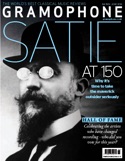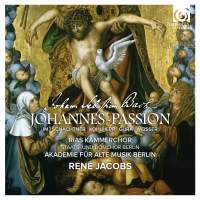Texte paru dans: / Appeared in: |
|
|
Outil de traduction (Très approximatif) |
|
|
Reviewer:
Lindsay Kemp
He uses a 20-strong choir which includes the aria soloists (the bass is Christus as well), who sometimes also form a solo ensemble for textural contrast or as a dramatic intensifier (for instance in crowd choruses), and there is a larger chorus for the chorales, given churchy colour by some boy sopranos. Jacobs arranges them all in a circle with choir and soloists on the right, melody instruments on the left and the continuo and Evangelist in the middle, a set-up that helps separate the work’s strands and brings the winds further into the light, but which means the vocal soloists can sound more recessed than usual.
Being more compact in form and forces than the St Matthew, the St John perhaps makes it easier to achieve consistency of tone. As ever, Jacobs picks singers to suit his purpose, and all here show a controlled expressive ardency that never allows the performance’s emotional coherence to slip. Werner Güra’s Evangelist is both elegant and immediate, the Akademie für Alte Musik Berlin are typically excellent, and while the RIAS Chamber Choir is not as coolly blended an ensemble as some, who says it has to be in a piece where personal involvement counts for so much? Tempi are kept moving but are never rushed, the phrasing is well defined and the fermatas in the chorales are movingly effective as steadying moments of reflection – just enough – before moving on to the next line. It all adds up to a reading of power and intelligence.
This
recording is of the final 1749 revision of the St John but the CDs come
with a handy appendix of the movements from Bach’s 1725 version – the one most
different from the ‘standard’, opening with the chorus ‘O Mensch, bewein’ later
used in the Matthew – and there is an option to download it whole. |
|
|
Support us financially by purchasing this disc from eiher one of these
suppliers.
|
|
|
|
|
|
Cliquez l'un ou l'autre
bouton pour découvrir bien d'autres critiques de CD |
|




